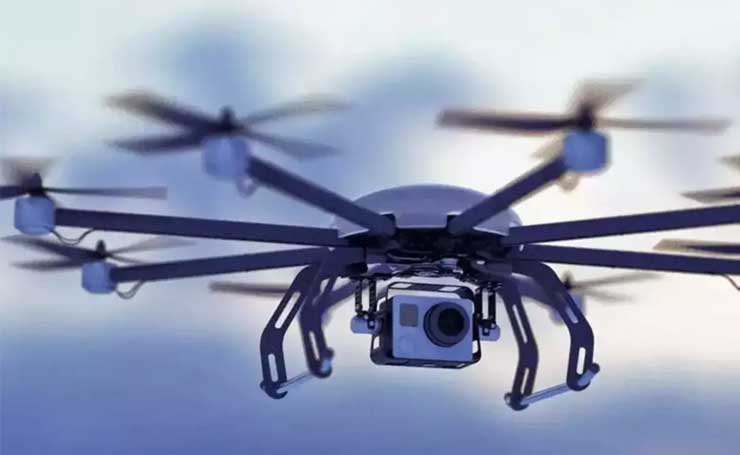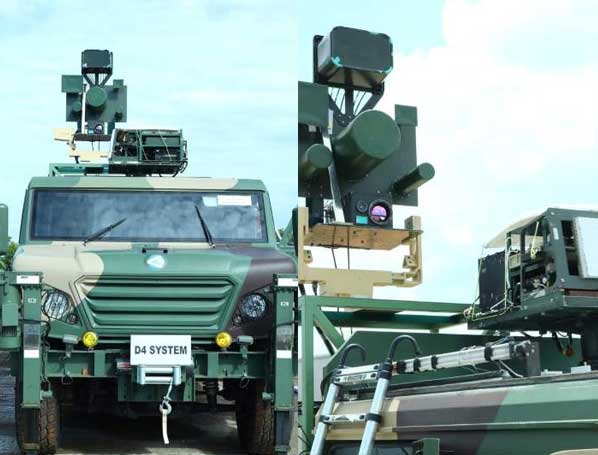
The first Defender anti-drone product from RattanIndia Enterprises was released on Wednesday. The step-down subsidiary Throttle Aerospace Systems of RattanIndia Enterprises is the company that created the anti-drone. Early in the year, NeoSky India Ltd, a wholly owned subsidiary of RattanIndia, purchased a 60% stake in Throttle Aerospace. NeoSky India is the drone company that Rattan India uses in the country.
Thirty percent of the BLDC motor and batteries will be imported, making Defender a 70% locally produced product. Throttle Aerospace’s manufacturing facility in Bengaluru will be where the production will be done.
This product can be operated manually or with the aid of artificial intelligence, which enables it to modify its position in response to movements made by rogue drones. According to Nagendran Kandasamy, CEO of Throttle Aerospace Systems, the soft-kill mechanism also aids in the recovery of errant drones that can aid in further investigation.
According to representatives from NeoSky and Throttle Aerospace, the company currently produces 45 to 50 drones per month, but production of Defender will depend on market demand. Although there are several potential customers for the product, the company has not yet received an order. It does, however, think that the product’s cost effectiveness will be to its benefit.
NeoSky India is also working on consumer drones, and future operations between NeoSky India and Throttle Aerospace are anticipated to be streamlined. Throttle is probably going to concentrate on commercial and military drones, whereas NeoSky may work specifically on consumer drones.
Drones marketed as “consumer goods” are frequently used for leisure activities like event and wedding photography. Enterprise drones are those which are used by governments and private companies for survey, mapping, public safety, agriculture, among other things. By the end of the current financial year, the company plans to introduce more drones into the business and defence markets. On the National Stock Exchange, shares of RattanIndia Enterprises closed at 53.95, up 4.55%.
In terms of its capabilities and range, the drone system produced by the DRDO as a part of the government’s Make in India initiative is cutting edge and effective. As it replaces the drone system that the government had purchased from other nations, the newly developed drone also functions as a power statement. The anti-drone system is a component of India’s emphasis on domesticating defence goods. Recently, the DRDO tested a number of other defence systems and goods that the defence ministry had also unveiled.
Military Anti-Drone System
The Indian Navy recently signed a contract with Bharat Electronics Limited (BEL) for India’s domestic Naval Anti Drone System, and the IAF has just recently done the same (NADS). This year’s Republic Day parade and the Prime Minister’s address to the nation on Independence Day both had the anti-drone system in use at first. For the Modi-Trump roadshow, the system, which provides 360-degree coverage, was also set up in Ahmedabad.
The Indian Navy will be able to secure its onshore installations with the system’s mobile and static versions, both of which are available. This will be used for all crucial assets, such as airfields used by the navy for air assets. The drones can be located and jammed with the aid of radar, electro-optical/infrared sensors, and radio frequency detectors. The signals are then jammed after the RF/Global Navigation Satellite System (GNSS) of the DRDO determines the frequency being used by the controller.
The Indian Armed Forces have access to both “soft kill” and “hard kill” options through the DRDO’s anti-drone technology system to counter rapidly emerging aerial threats. After the contract is signed, the Indian Navy will receive both the static and mobile NADS versions, according to the Ministry of Defence.
IAF Awards Rs 155 crore Contract for Anti-drone System
The IAF recently placed an order for Counter Unarmed Aircraft System, also known as anti-drone platforms, in the amount of Rs 155 crore. Zen Technologies, a company based in Hyderabad, won the contract and will deliver the system in a year. The company remains confident in securing additional orders in the future, according to a statement from Zen Technologies, which described this as its first significant order in the anti-drone space.
This is a crucial step towards making India a hub for the export of drone and anti-drone technology, according to Zen Technologies managing director and CFO Ashok Atluri. Due to the high export potential of goods like anti-drone systems to friendly foreign nations, these orders placed with Indian businesses may multiply the impact on the Indian equipment manufacturing industry.
The IAF’s Anti-drone Needs
To shoot down rogue drones, the Indian Air Force (IAF) wants 10 anti-drone systems outfitted with laser-directed energy weapons. A day after the attack on the Jammu Air Force Station, where bombs were dropped using unmanned aerial vehicles (UAVs), the Request for Information (RFI) was released.

“It should offer a multi-sensor, multi-kill solution to effectively enforce no-fly zones for unmanned aircraft while causing the least amount of collateral damage to the surrounding area.” According to the RFI’s requirements, it should produce a composite air situational picture for the operator and alerts based on user-defined criteria. A radar with a 360-degree coverage and a 5 km range should be required for a small unmanned aircraft system, among other requirements, are listed.
An indigenous Electrical Power Supply (EPS) system should be used to power the platform, which should be mounted on native vehicles with cross-country mobility. The counter unmanned aircraft systems ought to be designed to allow mounting on a rooftop or open ground and demounting of all subsystems, including the vehicle’s integral power source.
An Indian Anti-drone System was created by DRDO
The Defence Research and Development Organization (DRDO) has created a drone-detection, interception, and defeat technology. BEL was the recipient of the technology transfer, though other businesses are also being taken into consideration. The system was used by the DRDO last year during occasions like Republic Day, but many believe that more testing is necessary before it can be used for round-the-clock monitoring in hostile territory.
The system is designed to jam drones up to three kilometers away and can destroy targets with a laser weapon at distances of one to two kilometres. Additionally, there are options from the private sector that require careful consideration. The Hyderabad-based Grene Robotics claimed to have created the Indrajaal drone dome, which can protect against threats from drones.
Israeli SMASH 2000 Plus
Drones can be brought down with the help of the rifle-mounted SMASH 2000 Plus system. Israeli technology accurately detects, follows, and engages targets in the air.
While the Indian Navy has already chosen the Israeli anti-drone Smash 2000 Plus system, the Jammu attack serves as a sobering reminder for other forces to acquire comparable capabilities to defend against drone attacks. To improve their capabilities against drones on the ground, the Indian Army and Border Security Forces are also considering purchasing the weapon.
Among those who employ the system that can track and pursue numerous targets are the US and Israeli armed forces.
The SMASH 2000 system, created by the Israeli company Smart Shooter, makes it possible for any soldier on the ground to be outfitted with anti-drone capabilities because it can be quickly mounted on rifles.
– The writer is an Aerospace and Defence Analyst & Director ADD Engineering Components (India) Pvt Ltd (An Indo- German Company). The views expressed are of the author and do not necessarily reflect the views of Raksha Anirveda








